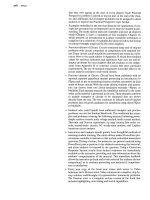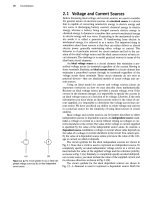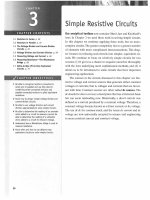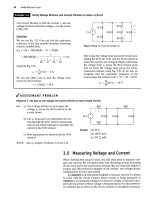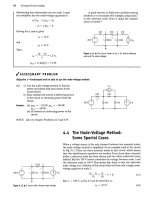Electric Circuits, 9th Edition P43 potx
Bạn đang xem bản rút gọn của tài liệu. Xem và tải ngay bản đầy đủ của tài liệu tại đây (1.01 MB, 10 trang )
396 Sinusoidal Steady-State Power Calculations
Figure P10.61
255/0!
rl
V (rms)
40
ft
;200
f)
720
ft
j 1500
ft N
2
rVi
Ideal
6800
ft
10.65
The
ideal transformer connected
to the 10 ft
load
in Problem
10.64 is
replaced with
an
ideal trans-
former that
has a
turns ratio
of a:\.
a) What value
of a
results
in
maximum average
power being delivered
to the 10 ft
resistor?
b) What
is the
maximum average power?
10.62
The
variable load resistor
R
L
in the
circuit shown
in
PSPICE
Fig. PI0.62
is
adjusted
for
maximum average power
MULTISIM
transfer to i?
L
.
a) Find
the
maximum average power.
b) What percentage
of the
average power developed
by
the
ideal voltage source
is
delivered
to R
L
when
R
L
is
absorbing maximum average power?
c) Test your solution
by
showing that
the
power
developed
by the
ideal voltage source equals
the
power dissipated
in the
circuit.
Figure P10.62
80
ft
20
ft 40 ft
1
1:2 i
500/0°
f +
V (rms)
360
ft
10.63 Repeat Problem
10.62 for the
circuit shown
in
PSPICE
Fig. P10.63.
MULTISIM
Figure P10.63
40/0!
f
+
V(vms)\-
10.64 Find
the
average power delivered
to the 10 ft
resis-
tor
in the
circuit
of
Fig. P10.64.
Figure P10.64
2.5
ft
a
l :201
-
7|30:11
(
i i
\
) \
Ideal
I
•
[ideal]
10ft
Sections 10.1-10.6
10.66
The
hair dryer
in the
Practical Perspective uses
a
piwrecnvi
60 Hz
smusoidal
voltage
of
120
V
(rms). The heater
element must dissipate
250 W at the
LOW
setting,
500 W at the
MEDIUM
setting, and 1000 W at the
HIGH
setting.
a) Find
the
value
for
resistor
R2
using
the
specifica-
tion
for the
MEDIUM
setting, using Fig.
10.31.
b) Find
the
value
for
resistor
Ri
using
the
specifica-
tion
for the
LOW
setting, using
the
results from
part
(a) and
Fig. 10.30.
c)
Is the
specification
for the
HIGH
setting satisfied?
10.67
As
seen
in
Problem 10.66, only
two
independent
PRACTICAL
power specifications
can be
made when
two
resis-
PERSPECTIVE
*
r
PSPICE
tors make
up the
healing element
of the
hair dryer.
a) Show that
the
expression
for the
HIGH
power
rating
(P
H
) is
PH
=
Pi
PA
pr
where
P
M
= the
MEDIUM
power rating
and
P
L
= the
LOW
power rating.
b)
If P
L
=
250
W and P
M
=
750
W,
what must
the
HIGH
power rating
be?
10.68 Specify
the
values
of R\ and R
2
in the
hair dryer
cir-
pRAcncAt
cu
it
in Fig. 10.29 if the low
power rating
is 240 W
PERSPECTIVE
b
r 0
PSPICE
and the
high power rating
is 1000 W
Assume
the
MULTISIM
supply voltage
is 120 V
(rms). (Hint: Work
Problem 10.67 first.)
10.69
If a
third resistor
is
added
to the
hair dryer circuit
in
PRACTICAL
Fig. 10.29,
it is
possible
to
design
to
three independ-
PSPICE
ent
power specifications.
If the
resistor
R$ is
added
MULTISIM
j
n
ser
i
es
w
ith
the
Thermal fuse, then
the
correspon-
ding
LOW,
MEDIUM,
and
HIGH
power circuit dia-
grams
are as
shown
in Fig.
P10.69.
If the
three
Problems 397
power settings are 600 W, 900 W, and 1200 W,
respectively, when connected to a 120 V (rms) sup-
ply, what resistor values should be used?
Figure P10.69
LOW MEDIUM HIGH
10.70 You have been given the job of redesigning the hair
PRACTICAL dryer described in Problem 10.66 for use in
'ERSPECTIVE
J
DESIGN
England. The standard supply voltage in England is
PROBLEM ± M. -mf i~J f
PSPICE
220 V (rms). What resistor values will you use in
MULTISIM your design to meet the same power specifications?
10.71 Repeat Problem 10.68 using single resistor values
from Appendix H. Calculate the resulting low,
medium, and high power ratings.
10.72 Repeat Problem 10.70 using single resistor values
from Appendix H. Calculate the resulting low,
medium, and high power ratings.
^.J.
I
H i^m
CHAPTER CONTENTS
11.1 Balanced Three-Phase Voltages p. 400
11.2 Three-Phase Voltage Sources p. 401
11.3 Analysis of the Wye-Wye Circuit p. 402
11.4 Analysis of the Wye-Delta Circuit p. 407
11.5 Power Calculations in Balanced Three-Phase
Circuits p. 410
11.6 Measuring Average Power in Three-Phase
Circuits p. 415
/CHAPTER OBJECTIVES
1 Know how to analyze a balanced, three-phase
wye-wye connected circuit.
2 Know how to analyze a balanced, three-phase
wye-delta connected circuit.
3 Be able to calculate power (average, reactive,
and complex) in any three-phase circuit.
398
Balanced
Three-Phase Circuits
Generating, transmitting, distributing, and using large blocks
of electric power is accomplished with three-phase circuits. The
comprehensive analysis of such systems is a field of study in its
own right; we cannot hope to cover it in a single chapter.
Fortunately, an understanding of only the steady-state sinusoidal
behavior of balanced three-phase circuits is sufficient for engi-
neers who do not specialize in power systems. We define what we
mean by a balanced circuit later in the discussion. The same cir-
cuit analysis techniques discussed in earlier chapters can be
applied to either unbalanced or balanced three-phase circuits.
Here we use these familiar techniques to develop several short-
cuts to the analysis of balanced three-phase circuits.
For economic reasons, three-phase systems are usually
designed to operate in the balanced state. Thus, in this introduc-
tory treatment, we can justify considering only balanced circuits.
The analysis of unbalanced three-phase circuits, which you will
encounter if you study electric power in later courses, relies heav-
ily on an understanding of balanced circuits.
The basic structure of a three-phase system consists of volt-
age sources connected to loads by means of transformers and
transmission
lines.
To analyze such a circuit, we can reduce it to a
voltage source connected to a load via a
line.
The omission of the
transformer simplifies the discussion without jeopardizing a basic
understanding of the calculations involved. Figure 11.1 on
page 400 shows a basic circuit. A defining characteristic of a bal-
anced three-phase circuit is that it contains a set of balanced
three-phase voltages at its source. We begin by considering these
voltages, and then we move to the voltage and current relation-
ships for the Y-Y and Y-A circuits. After considering voltage and
current in such circuits, we conclude with sections on power and
power measurement.
Practical Perspective
Transmission and Distribution
of
Electric Power
In this chapter we introduce circuits that are designed to
handle large blocks of electric power. These are the circuits
that are used to transport electric power from the generating
plants to both industrial and residential customers. We intro-
duced the typical residential customer circuit as used in the
United States as the design perspective in Chapter 9. Now we
introduce the type of circuit used to deliver electric power to
an entire residential subdivision.
One of the constraints imposed on the design and oper-
ation of an electric utility is the requirement that the utility
maintain the rms voltage level at the customer's premises.
Whether lightly loaded, as at 3:00 am, or heavily loaded, as
at midaftemoon on a hot, humid day, the utility is obligated
to supply the same rms voltage. Recall from Chapter 10 that
a capacitor can be thought of as a source of magnetizing
vars.
Therefore, one technique for maintaining voltage levels
on a utility system is to place capacitors at strategic loca-
tions in the distribution network. The idea behind this tech-
nique is to use the capacitors to supply magnetizing vars
close to the loads requiring them, as opposed to sending
them over the lines from the generator. We shall illustrate
this concept after we have introduced the analysis of bal-
anced three-phase circuits.
399
400 Balanced Three-Phase Circuits
Three-phase
Three-phase
voltage •
source
line
/ \
\
Three-phase
load
Figure 11.1 •
A
basic three-phase circuit.
11.1 Balanced Three-Phase Voltages
A set of balanced three-phase voltages consists of three sinusoidal volt-
ages that have identical amplitudes and frequencies but are out of phase
with each other by exactly 120°. Standard practice is to refer to the three
phases as a, b, and c, and to use the a-phase as the reference phase. The
three voltages are referred to as the a-phase voltage, the b-phase voltage,
and the c-phase voltage.
Only two possible phase relationships can exist between the a-phase
voltage and the b- and c-phase voltages. One possibility is for the b-phase
voltage to lag the a-phase voltage by 120°, in which case the c-phase volt-
age must lead the a-phase voltage by 120°. This phase relationship is
known as the abc (or positive) phase sequence. The only other possibility
is for the b-phase voltage to lead the a-phase voltage by 120°, in which
case the c-phase voltage must lag the a-phase voltage by 120°. This phase
relationship is known as the acb (or negative) phase sequence. In phasor
notation, the two possible sets of balanced phase voltages are
V
h
= V
IM
/-120'
v
c
= y
m
/+120-
(11.1)
and
v
m
/o\
V
h
= 1/,,,/ + 120°,
V
c
= ^,,,/-120°.
(11.2)
Equations 11.1 are for the abc, or positive, sequence. Equations 11.2
are for the acb, or negative, sequence. Figure 11.2 shows the phasor dia-
grams of the voltage sets in Eqs. 11.1 and 11.2. The phase sequence is
the clockwise order of the subscripts around the diagram from V
a
. The
fact that a three-phase circuit can have one of two phase sequences
must be taken into account whenever two such circuits operate in par-
allel. The circuits can operate in parallel only if they have the same
phase sequence.
Another important characteristic of a set of balanced three-phase
voltages is that the sum of the voltages is zero. Thus, from either Eqs. 11.1
or Eqs. 11.2,
Figure 11.2 A Phasor diagrams of
a
balanced set of
three-phase voltages, (a) The abc (positive) sequence,
(b)
The
acb (negative) sequence.
V
fl
+ V„ + V
r
= 0.
(11.3)
Because the sum of the phasor voltages is zero, the sum of the instanta-
neous voltages also is zero; that is,
v
&
+ v
h
+ v
c
= 0.
(11.4)
Now that we know the nature of a balanced set of three-phase volt-
ages,
we can state the first of the analytical shortcuts alluded to in the
introduction to this chapter: If we know the phase sequence and
one voltage in the set, we know the entire set. Thus for a balanced three-
phase system, we can focus on determining the voltage (or current) in one
phase, because once we know one phase quantity, we know the others.
NOTE: Assess your understanding of three-phase voltages by trying
Chapter Problems 11.2 and 11.3.
11.2 Three-Phase Voltage Sources
401
11.2 Three-Phase Voltage Sources
A three-phase voltage source is a generator with three separate wind-
ings distributed around the periphery of the stator. Each winding com-
prises one phase of the generator. The rotor of the generator is an
electromagnet driven at synchronous speed by a prime mover, such as a
steam or gas turbine. Rotation of the electromagnet induces a sinusoidal
voltage in each winding. The phase windings are designed so that the
sinusoidal voltages induced in them are equal in amplitude and out of
phase with each other by 120°. The phase windings are stationary with
respect to the rotating electromagnet, so the frequency of the voltage
induced in each winding is the same. Figure 11.3 shows a sketch of a two-
pole three-phase source.
There are two ways of interconnecting the separate phase windings to
form a three-phase source: in either a wye (Y) or a delta (A) configura-
tion. Figure 11.4 shows both, with ideal voltage sources used to model the
phase windings of the three-phase generator. The common terminal in the
Y-connected source, labeled n in Fig. 11.4(a), is called the neutral terminal
of the source. The neutral terminal may or may not be available for exter-
nal connections.
Sometimes, the impedance of each phase winding is so small (com-
pared with other impedances in the circuit) that we need not account for it
in modeling the generator; the model consists solely of ideal voltage
sources, as in Fig. 11.4. However, if the impedance of each phase winding is
not negligible, we place the winding impedance in series with an ideal
sinusoidal voltage source. All windings on the machine are of the same
construction, so we assume the winding impedances to be identical. The
winding impedance of a three-phase generator is inductive. Figure 11.5
shows a model of such a machine, in which is the winding resistance, and
X
w
is the inductive reactance of the winding.
Because three-phase sources and loads can be either Y-connected
or A-connected, the basic circuit in Fig. 11.1 represents four different
configurations:
Source
Y
Y
A
A
Load
Y
A
Y
A
We begin by analyzing the Y-Y circuit. The remaining three arrangements
can be reduced to a Y-Y equivalent circuit, so analysis of the Y-Y circuit is
the key to solving all balanced three-phase arrangements. We then illus-
trate the reduction of the Y-A arrangement and leave the analysis of the
A-Y and A-A arrangements to you in the Problems.
Axis of
a-phase
winding
Axis of
c-phasc
windine
\
Axis of
b-phase
winding
Stator
Figure 11.3 A
A
sketch of
a
three-phase voltage source.
Figure 11.4 A
The two
basic connections of
an
ideal
three-phase source, (a)
A
Y-connected source,
(b)
A
A-connected source.
402 Balanced Three-Phase Circuits
R,
.Ifiw
R,r
jx
w
iv
b
fX*
R,r
^vw-
JX
W
JXu
(a)
(b)
Figure 11.5 • A model of a three-phase source with winding impedance: (a) a Y-connected source; and
(b) a A-connected source.
11.3 Analysis of the Wye-Wye Circuit
Figure 11.6 illustrates a general Y-Y circuit, in which we included a fourth
conductor that connects the source neutral to the load neutral. A fourth
conductor is possible only in the Y-Y arrangement. (More about this
later.) For convenience, we transformed the Y connections into "tipped-
over tees." In Fig. 11.6, Z
ga
, Z
gb
, and Z
gc
represent the internal impedance
associated with each phase winding of the voltage generator; Z
la
, Z
lb
, and
Z
lc
represent the impedance of the lines connecting a phase of the source
to a phase of the load; Z
0
is the impedance of the neutral conductor con-
necting the source neutral to the load neutral; and
ZA,
Z
B
, and ZQ repre-
sent the impedance of each phase of the load.
We can describe this circuit with a single node-voltage equation.
Using the source neutral as the reference node and letting V
N
denote the
node voltage between the nodes N and n, we find that the node-voltage
equation is
Z
0
+
V
N
-V
a
ZA
+ Z
ia
+
-¾
b'n
Zn + ZII, + Z
lb
+
'gb
VN ~ Ve'n
Zc + Z
lc
+ Z
fiC
= 0.
(11.5)
v •
'an
V •
*
c
n
v
1
t
C
T
7
^6-
) V
b
-
n
Zgb
a
I
n
b
c
Zia
z„
Zib
Zlc
A
laA
N
i
t
;c
Z
B
Z
A
Z
c
Figure 11.6 •
A
three-phase Y-Y system.
11.3 Analysis of the Wye-Wye Circuit
403
This is the general equation for any circuit of the Y-Y configuration
depicted in Fig. 11.6. But we can simplify Eq. 11.5 significantly if we now
consider the formal definition of a balanced three-phase circuit. Such a
circuit satisfies the following criteria:
1.
The voltage sources form a set of balanced three-phase voltages.
In Fig. 11,6, this means that V
a
-
n
, V
b
<
n
, and V
c
<
n
are a set of bal-
anced three-phase voltages.
2.
The impedance of each phase of the voltage source is the same. In
Fig. 11.6, this means that Z
ga
= Z
gb
= Z
gc
.
3.
The impedance of each line (or phase) conductor is the same. In
Fig. 11.6, this means that Zi
a
= Z^ = Z\
c
.
4.
The impedance of each phase of the load is the same. In Fig. 11.6,
this means that Z
A
= Z
B
= ZQ.
There is no restriction on the impedance of a neutral conductor; its
value has no effect on whether the system is balanced.
If the circuit in Fig. 11.6 is balanced, we may rewrite Eq. 11.5 as
< Conditions for a balanced three-phase
circuit
1^
+
A)
• a
r
T\ l * IVn I * r
(11.6)
where
Z& - Z
A
+ Z
la
+ Zga - Z
B
+ Z
]b
+ Zgb
—
Z
c
+ Z
lc
+ Z
gc-
The right-hand side of Eq. 11.6 is zero, because by hypothesis the numera-
tor is a set of balanced three-phase voltages and Z^ is not zero. The only
value of V
N
that satisfies Eq. 11.6 is
zero.
Therefore, for a balanced three-
phase circuit,
VM = 0.
(11.7)
Equation 11.7 is extremely important. If V
N
is zero, there is no differ-
ence in potential between the source neutral, n, and the load neutral, N;
consequently, the current in the neutral conductor is zero. Hence we may
either remove the neutral conductor from a balanced Y-Y configuration
(It, = 0) or replace it with a perfect short circuit between the nodes n and
N (V
N
= 0). Both equivalents are convenient to use when modeling bal-
anced three-phase circuits.
We now turn to the effect that balanced conditions have on the three
line currents. With reference to Fig. 11.6, when the system is balanced, the
three line currents are
f
laA
h\i
I
Va'n"
Z
A
+ Z
la
v„„
-
ZB + Z\b
v
c
-
n
-
v
N
+ z
ga
V
N
+ z
gb
V
N
»cC
Z<i>
\w
b'n
V
c
<
n
%C
+
Z\c + Zee Z„
(11.8)
(11.9)
(11.10)
We see that the three line currents form a balanced set of three-phase cur-
rents;
that is, the current in each line is equal in amplitude and frequency
and is 120° out of phase with the other two line
currents.
Thus,
if we calcu-
late the current I
aA
and we know the phase sequence, we have a shortcut
Balanced
Three-Phase Circuits
a'
T
X
:)
I
z
•^ga
a
Z
ia
c
A
Z
A
—o
v
0
.„i
Figure
11.7 A A single-phase equivalent circuit.
N
for finding I
bB
and I
cC
. This procedure parallels the shortcut used to find
the b- and c-phase source voltages from the a-phase source voltage.
We can use Eq. 11.8 to construct an equivalent circuit for the a-phase
of the balanced Y-Y circuit. From this equation, the current in the a-phase
conductor line is simply the voltage generated in the a-phase winding of
the generator divided by the total impedance in the a-phase of the circuit.
Thus Eq. 11.8 describes the simple circuit shown in Fig. 11.7, in which the
neutral conductor has been replaced by a perfect short circuit. The circuit
in Fig. 11.7 is referred to as the single-phase equivalent circuit of a bal-
anced three-phase circuit. Because of the established relationships
between phases, once we solve this circuit, we can easily write down the
voltages and currents in the other two phases. Thus, drawing a single-
phase equivalent circuit is an important first step in analyzing a three-
phase circuit.
A word of caution here. The current in the neutral conductor in
Fig. 11.7 is I
aA
, which is not the same as the current in the neutral conduc-
tor of the balanced three-phase circuit, which is
I,
LA
+ IhR + I,
la
A
bB
IcC-
(11.11)
+-f-
VAB
' ? +
T
+
V
BC
+
V
AN
VCN
Z
B
ZA
-
—
iN
Zc
Figure 11.8 A Line-to-line and line-to-neutral voltages.
Thus the circuit shown in Fig. 11.7 gives the correct value of the line cur-
rent but only the a-phase component of the neutral current. Whenever
this single-phase equivalent circuit is applicable, the line currents form
a balanced three-phase set, and the right-hand side of Eq. 11.11 sums
to zero.
Once we know the line current in Fig. 11.7, calculating any voltages of
interest is relatively simple. Of particular interest is the relationship
between the line-to-line voltages and the line-to-neutral voltages. We
establish this relationship at the load terminals, but our observations also
apply at the source terminals. The line-to-line voltages at the load termi-
nals can be seen in Fig.
11.8.
They are V
AB
, V
BC
, and VCA> where the dou-
ble subscript notation indicates a voltage drop from the first-named node
to the second. (Because we are interested in the balanced state, we have
omitted the neutral conductor from Fig. 11.8.)
The line-to-neutral voltages are V
AN
, V
BN
, and V
CN
. We can now
describe the line-to-line voltages in terms of the line-to-neutral voltages,
using Kirchhoff s voltage law:
AB
AN
VBN,
(11.12)
BC
VRN
V
CN
,
(11.13)
CA
'CN
AN-
(11.14)
To show the relationship between the line-to-line voltages and the
line-to-neutral voltages, we assume a positive, or abc, sequence. Using the
line-to-neutral voltage of the a-phase as the reference,
VAN
=
V*/01,
BN
VA/-120-,
VCN
= v,/+i2o;
(11.15)
(11.16)
(11.17)
11.3 Analysis of
the Wye-Wye
Circuit 405
where V^ represents the magnitude of the line-to-neutral voltage.
Substituting Eqs. 11.15-11.17 into Eqs. 11.12-11.14, respectively, yields
AB
BC
Vs /0° - ^/-120° =
V3V,
h
/30°,
(11.18)
V* /-120° - V* /120° = s/Wj,
/-90°,
(11.19)
Y
CA
= J^/12GT - ^/0£ = V3>
<6
/150°.
(11.20)
Equations 11.18-11.20 reveal that
1.
The magnitude of the line-to-line voltage is V3 times the magni-
tude of the line-to-neutral voltage.
2.
The line-to-line voltages form a balanced three-phase set of voltages.
3.
The set of line-to-line voltages leads the set of line-to-neutral volt-
ages by 30°.
We leave to you the demonstration that for a negative sequence, the only
change is that the set of line-to-line voltages lags the set of line-to-neutral
voltages by 30°. The phasor diagrams shown in Fig. 11.9 summarize these
observations. Here, again, is a shortcut in the analysis of a balanced sys-
tem: If you know the line-to-neutral voltage at some point in the circuit,
you can easily determine the line-to-line voltage at the same point and
vice versa.
We now pause to elaborate on terminology. Line voltage refers to the
voltage across any pair of lines; phase voltage refers to the voltage across
a single phase. Line current refers to the current in a single line; phase
current refers to current in a single phase. Observe that in a A connec-
tion, line voltage and phase voltage are identical, and in a Y connection,
line current and phase current are identical.
Because three-phase systems are designed to handle large blocks of
electric power, all voltage and current specifications are given as rms val-
ues.
When voltage ratings are given, they refer specifically to the rating of
the line voltage. Thus when a three-phase transmission line is rated at
345 kV, the nominal value of the rms line-to-line voltage is 345,000 V. In
this chapter we express all voltages and currents as rms values.
Finally, the Greek letter phi
(<f>)
is widely used in the literature to
denote a per-phase quantity. Thus V^„ I,
/(
, Z^, P^ and Q^ are interpreted
as voltage/phase, current/phase, impedance/phase, power/phase, and
reactive power/phase, respectively.
Example 11.1 shows how to use the observations made so far to solve
a balanced three-phase Y-Y circuit.
Figure 11.9 A Phasor diagrams showing the relation-
ship between line-to-tine and line-to-neutral voltages in
a balanced system, (a)
The
abc sequence, (b)
The
acb
sequence.
Example 11.1
Analyzing a Wye-Wye Circuit
A balanced three-phase Y-connected generator
with positive sequence has an impedance of
0.2 + y'0.5 il/4 and an internal voltage of 120
V/<f>.
The generator feeds a balanced three-phase
Y-connected load having an impedance of
39 + /28
fl/4>.
The impedance of the line connect-
ing the generator to the load is 0.8 + /1,5
(l/4>.
The
a-phase internal voltage of the generator is speci-
fied as the reference phasor.
a) Construct the a-phase equivalent circuit of
the system.
b) Calculate the three line currents I
aA
, I
bB
, and I
cC
.
c) Calculate the three phase voltages at the load.
VAN, VBN< and V
CN
.
d) Calculate the line voltages V
AB
, V
1}C
> and \
C
A at
the terminals of the load.



